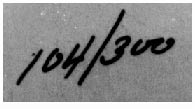Decoration Markings
The introduction of decoration markings coincides with the assigning of style numbers. They both appear in Medalta’s stock ledger at the same time, and they are usually found together on the item, especially in the early years. In the example illustrated here, the104 is the style No. of the vase while the appended 300 indicated the decoration, which in this case is the swallow flying over lily pads. Within a few years when the style No. was right in the mould, the decoration number was often added to it. Most of the numbers that you will find are on pieces finished in coloured lacquers, and the decoration numbers are usually in either black or white. Although they are not common, you can find some glazed pieces where the number has been appended using an oxide. The only ones I have seen so far are decoration numbers 43, 44, 45, 2000 and 2001, but others are bound to show up.
That these numbers were used by Medalta’s agents in taking and placing orders is attested to in many letters in the Medalta files. In October 1937 Medalta’s Toronto agent wrote:
“...A local florist wants two # 2/14” vases in a light blue decoration. The blue mottled glaze style 2500 is too dark, and if there is not a light blue glaze, there is no doubt a lacquered decoration of this shade.”11
Three years later the Montreal agent, Medalta Sales Reg’d., wrote:
“...I have just checked over my stock and find that I am out of size 36 yellow tea pots in mottled 3500 and the new design 170A.”12
I picked these letters out of the many to choose from as they are typical of what you find in the files. They give some description of a colour, but not quite enough to match it to a glaze that has been seen on an item. Other times, like the reference to No. 170A, they indicate when a new glaze first came out. So far, neither of these numbers has been found on an item.
Another style of decoration number was adopted in 1937 and was used through to some time in 1939. It consisted of three parts - a letter G, L or S followed by two numbers separated by a slash. The letters stood for the type of finish, including glaze and lacquer. What S stood for is not specifically indicated in the letters, but it may have indicated a satina or slip glaze.
The first number was the year the decoration came out and you can find 37, 38 or 39. The number after the slash was the specific decoration, and they appear to range from 1 to 40 for some of the finishes. Once a decoration was developed and assigned a number, it seems to have remained in use until it was dropped. In other words, Medalta did not reassign new numbers on a yearly basis. The 1940 letters and invoices are full of references to the 1938 decorations. For example an invoice dated 9 September 1940 states: “Cane Mixing bowls - white lined and decorated G38/10 (cow)”.13
But to balance the record, I should also point out that customers frequently referred to some decorations by name alone, such as the cow and church decorations. And colours were often referred to by just the colour and not a number which presumably they had. For example in enquiring about one order for lamp bases the agent wrote:
Order 734 of July 5th was, in part, for base No 414 in the following Color proportions: Base 414 Oxblood, Brown, Green, Yellow, Gray-Blue, Ivory Total
100 100 100 75 50 75 500 14
I could list all the decoration numbers that I have run across either on products or in the Medalta files, but quite frankly it would be of little use to anyone as most have never been seen on products. Those that have been found is actually quite a long list in itself, and so I will limit Table II to those alone. This table also gives the date or dates when that decoration number appears in the Medalta stock ledger. Most appear for only a year or two, so the presence of these numbers may be a good date indicator. Also, I have listed the item(s) that they were on, but you can be sure that they were on other products as well. Some decorations may have been limited to a single product, but most were not. For example, many collectors may think that the No. 45 apple blossom decoration is found only on cookie jars, but that is not the case. It has shown up on a lamp base and a teapot. Others, like the tulip decoration, I have seen only on cookie jars. But who knows, in time they too may be found on other products.
Copyright rongetty.com, All Rights Reserved
Login - 216.73.216.26
